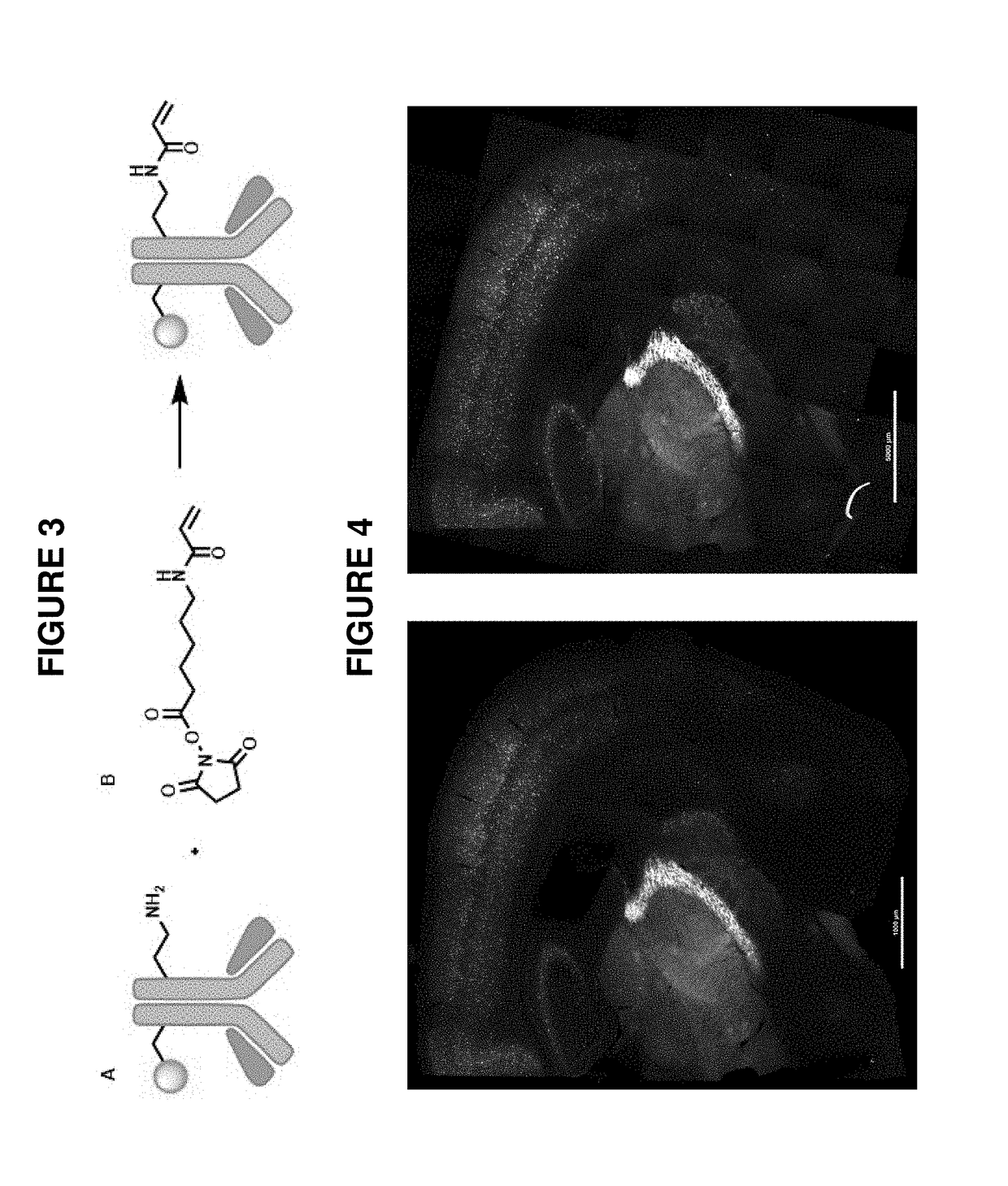Combining modified antibodies with expansion microscopy for in-situ, spatially-resolved proteomics
- Summary
- Abstract
- Description
- Claims
- Application Information
AI Technical Summary
Benefits of technology
Problems solved by technology
Method used
Image
Examples
example 1
[0095]A target biomolecule of interest is identified, and an antibody having an antigen-binding site with an affinity for the target biomolecule is obtained. The antibody is modified to be operably linked to a detectable label and also operably linked to a polyelectrolyte gel binding moiety to yield a modified antibody. The modified antibody is a binding composition or a component of the binding composition.
[0096]A biological sample of interest is obtained. The sample is contacted with the binding composition under conditions where it selectively recognizes the target biomolecule. The biological sample is incubated with the detection reagent, in some cases together with the labeling reagent, under conditions that allow a complex between the detection reagent (and labeling reagent) and target to form. Upon treatment with a solution of monomers and subsequent free radical polymerization, a polyelectrolyte gel is formed to which the polyelectroylte gel binding moiety (operably linked t...
example 2
[0097]A target biomolecule of interest is identified, and an antigen-binding fragment having an antigen-binding site with an affinity for the target biomolecule is obtained. The antigen-binding fragment is modified to be operably linked to a detectable label and also operably linked to a polyelectrolyte gel binding moiety to yield a modified antigen-binding fragment. The modified antigen-binding fragment is a binding composition or a component of the binding composition.
[0098]A biological sample of interest is obtained. The sample is contacted with the binding composition under conditions where it selectively recognizes the target biomolecule. The biological sample is incubated with the detection reagent, in some cases together with the labeling reagent, under conditions that allow a complex between the detection reagent (and labeling reagent) and target to form. Upon treatment with a solution of monomers and subsequent free radical polymerization, a polyelectrolyte gel is formed to...
example 3
[0099]As described in Example 1(above), a target biomolecule of interest (a primary anti-PV antibody to murine parvalbumin protein) was identified, and an antibody having an antigen-binding site with an affinity for the target biomolecule was obtained (here, a secondary antibody to the primary anti-PV antibody). This secondary antibody was modified to be operably linked to a fluorophore (an atto647N dye) and also operably linked to a polyelectrolyte gel binding moiety to yield a modified antibody, as shown in FIG. 3.
[0100]A mouse brain sample was obtained. The sample was first contacted with the primary anti-PV antibody and then contacted with the binding composition comprising the modified secondary antibody under conditions where it selectively recognizes the primary anti-PV antibody target biomolecule. In each case, the sample was incubated under conditions that allow a complex between the detection reagent (and labeling reagent) and target to form. Upon treatment with a solution...
PUM
 Login to View More
Login to View More Abstract
Description
Claims
Application Information
 Login to View More
Login to View More - R&D
- Intellectual Property
- Life Sciences
- Materials
- Tech Scout
- Unparalleled Data Quality
- Higher Quality Content
- 60% Fewer Hallucinations
Browse by: Latest US Patents, China's latest patents, Technical Efficacy Thesaurus, Application Domain, Technology Topic, Popular Technical Reports.
© 2025 PatSnap. All rights reserved.Legal|Privacy policy|Modern Slavery Act Transparency Statement|Sitemap|About US| Contact US: help@patsnap.com



